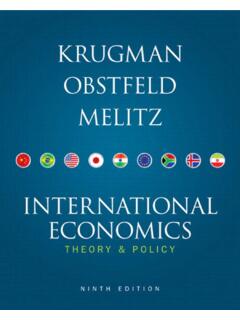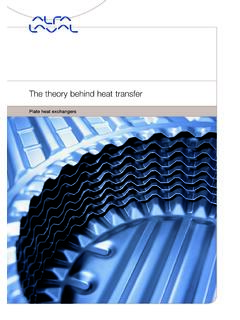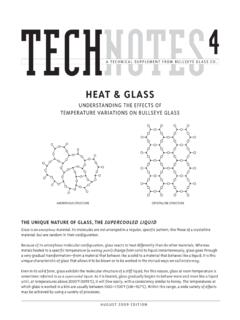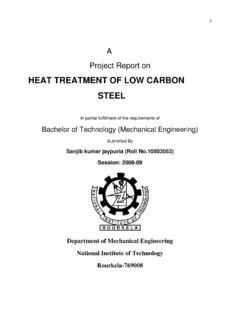Transcription of Heat Transfer in Food Processing - Prexams
1 Chapter4 heat Transfer in Food ProcessingThe most common processes found in a food Processing plantinvolve heating and cooling of foods. In the modern industrializedfood industry,we commonly find unit operations such as refrigera-tion,freezing,thermal sterilization,drying,and evaporation. Theseunit operations involve the Transfer of heat between a product andsome heating or cooling medium. Heating and cooling of food pro-ducts is necessary to prevent microbial and enzymatic addition,desired sensorial properties color,flavor,texture areimparted to foods when they are heated or study of heat Transfer is important because it provides a basis forunderstanding how various food processes operate.
2 In this chapter,wewill study the fundamentals of heat Transfer and learn how they arerelated to the design and operation of food Processing will begin by studying heat -exchange equipment. We will observethat there is a wide variety of heat -exchange equipment available forfood applications. This description will identify the need to study prop-erties of foods that affect the design and operation of heat ,we will examine various approaches to obtaining thermalproperties of foods. We will consider basic modes of heat Transfer suchas conduction,convection,and radiation. Simple mathematical equa-tions will be developed to allow prediction of heat Transfer in solidas well as liquid foods.
3 These mathematical equations will provide uswith sufficient tools to design and evaluate the performance of simpleheat exchangers. Next,we will consider more complicated situationsarising from heat Transfer under unsteady-state conditions,whentemperature changes with time. Agood understanding of the variousAll icons in this chapter refer tothe author s web site,which isindependently owned andoperated. Academic Press is notresponsible for the content oroperation of the author s web direct your web sitecomments and questions to theauthor: Professor R. Paul Singh,Department of Biological andAgricultural Engineering,University of California,Davis,CA 95616, : presented in this chapter is important,since they will be thebasis for topics in the following FOR HEATING ANDCOOLING FOOD PRODUCTSIn a food Processing plant,heating and cooling of foods is conductedin equipment called heat exchangers.
4 As shown inFigure ,heatexchangers can be broadly classified into non-contact and contacttypes. As the name implies,in non-contact-type heat exchangers,theproduct and heating or cooling medium are kept physically sepa-rated,usually by a thin wall. On the other hand,in contact-type heatexchangers,there is direct physical contact between the product andthe heating or cooling example,in a steam-injection system,steam is directly injectedinto the product to be heated. In a plate heat exchanger,a thin metalplate separates the product stream from the heating or cooling streamwhile allowing heat Transfer to take place without mixing. We willdiscuss some of the commonly used heat exchangers in the foodindustry in the following heat ExchangerThe plate heat exchanger invented more than 70 years ago has foundwide application in the dairy and food beverage industry.
5 A sche-matic of a plate heat exchanger is shown inFigure This heatexchanger consists of a series of parallel,closely spaced stainless-steelHeatexchangersNoncontactt ypeContacttypeScrapedsurfaceShell andtubeTubularPlateSteaminfusionSteaminj ection Figure of commonly usedheat Transfer in Food Processingplates pressed in a frame. Gaskets,made of natural or synthetic rub-ber,seal the plate edges and ports to prevent intermixing of gaskets help to direct the heating or cooling and the productstreams into the respective alternate gaps. The direction of the prod-uct stream versus the heating/cooling stream can be either parallelflow (same direction) or counterflow (opposite direction) to eachother.
6 We will discuss the influence of flow direction on the perfor-mance of the heat exchanger later inSection plates used in the plate heat exchanger are constructed fromstainless steel: Special patterns are pressed on the plates to causeincreased turbulence in the product stream,thus achieving betterheat Transfer . An example of such a pattern is a shallow herringbone-ribbed design,as shown inFigure heat exchangers are suitable for low-viscosity (,5 Pa s) liquidfoods. If suspended solids are present,the equivalent diameter of the(a)ProductMedia(b)w Figure (a) Plate heat exchanger.(b) Schematic view of fluid flow between plates.(Courtesy of Cherry-Burrell Corporation) for Heating and Cooling Food Productsparticulates should be less than cm.
7 Larger particulates can bridgeacross the plate contact points and burn on in the heating industrial-size plate heat exchangers,product flow rates from 5000to 20,000 kg/h often are obtained. When using plate heat exchangers,care should be taken to minimize the deposition of solid food mate-rial such as milk proteins on the surface of the plates. This deposition,also called fouling,will decrease the heat Transfer rate from the heatingmedium to the product; in addition,the pressure drop will increaseover a period of time. Eventually,the process is stopped and the platesare cleaned. For dairy products,which require ultra-high-temperatureapplications,the process time is often limited to 3 4 h.
8 Plate heatexchangers offer the following advantages: The maintenance of these heat exchangers is simple,and they canbe easily and quickly dismantled for product surface inspection. The plate heat exchangers have a sanitary design for foodapplications. Their capacity can easily be increased by adding more plates tothe frame. With plate heat exchangers,we can heat or cool product towithin 18C of the adjacent media temperature,with less capitalinvestment than other non-contact-type heat exchangers. Plate heat exchangers offer opportunities for energy conservationby shown in a simple schematic inFigure ,aliquidfoodisheatedtopasteurization or other desired temperature in the heating section; theheated fluid then surrenders part of its heat to the incoming raw fluidin the regeneration section.
9 The cold stream is heated to a temperaturewhere it requires little additional energy to bring it up to the desired Figure pressed on platesused on a plate heat exchanger. (Courtesy ofCherry-Burrell Corporation)268 CHAPTER4 heat Transfer in Food Processingtemperature. For regeneration,additional plates are required; however,the additional capital cost may be recovered quickly by lowered oper-ating actual two-way regeneration process is shown inFigure pasteurizing grape juice. After the starter juice has been heatedto 888C(atlocationA),it is passed through a holding loop and into theIce watercoolingMilk inMilk outHot waterChilled waterWell waterMilkWatercoolingRegenerativeheating /coolingHeatingExternal holding cellw Figure five-stage plate pasteurizer forprocessing milk.
10 (Reprinted with permission ofAlfa-Laval AB,Tumba,Sweden,and Alfa-Laval,Inc.,Fort Lee,New Jersey)Heating section(hot water at 93 C) C C13 C21 C53 C88 C88 C73 C38 C38 CJuice54321 BalancetankSilotankBCEDA12345 Regeneration sectionCooling with city waterCooling with chilled waterCooling with Glycolw Figure two-way regeneration systemused in Processing grape juice. (Courtesy ofAPV Equipment,Inc.) for Heating and Cooling Food Productsregenerative section (entering at location B). In this section,the juicereleases its heat to incoming raw juice entering (at location C) intothe exchanger at 388C. The temperature of raw juice increases to 738C(atlocation D),and the starter juice temperature decreases to 538C(atlocation E).














